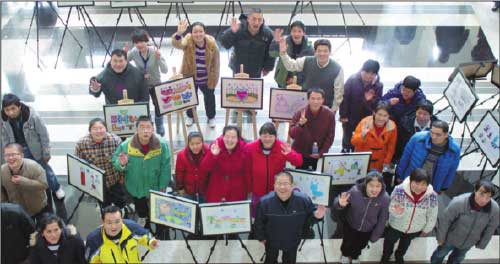当前位置: Language Tips> 双语新闻
【My China Dream】Autism meets art
 |
|
HeArts students and their family members gather at a painting show in Shanghai. |
|
In 2010, Guo Chenggang suddenly found his 30-month-old son to be "unusual". "He was unable to speak, very sensitive to sound and light. When playing in the kindergarten he would frequently turn to me-all symptoms of autism," Guo recalls. "I was full of guilt. My wife and I focused too much on work and had ignored our child." He decided to return to his family, committing to taking care of his son full time. His son's case proved to be a false alarm. As the boy grew older, the symptoms disappeared. "I guess it was just a period of his growth, but I had gone through all the anxiety, fear and torture that parents of autistic children experience," he says. Afterward, he says, he just could not get back on track and leave those experiences behind after learning so much about autistic children, their parents and families. Today, Guo heads "heArtS", a Shanghai-based charity group that teaches art to mentally impaired people through free painting classes. The 36-year-old man from Wuxi, Jiangsu province, is not an artist himself and says he does not expect to discover the next Vincent Van Gogh. However, he hopes to endow the students with the ability to express themselves-and also give them self-confidence and social recognition. An MBA graduate of Shanghai Jiaotong University with a marketing degree, he had foreseen an ambitious future in business and management. But his encounter with people challenged by autism changed his life. He is now running his NGO full time. He worked for more than two years as a volunteer helping the special-needs group-people with autism, Down syndrome and other mental disorders and illnesses. Last August, Guo and eight friends working in the field established the NGO to provide art classes to special-needs people. By February, the organization was offering free weekly painting lessons to 245 people in 14 communities in Shanghai, Beijing and Hangzhou, with more than 600 paintings being produced each month. Guo believes that people can express their inner selves through art, and says painting is the easiest art form that special-needs people can master. "The art class does not focus on painting skills, and there is not any limitation on the colors or content. Instead, the students are encouraged to bravely express themselves," he says. A crucial part of the art class is sharing. Students are invited to show their work, explain the paintings and answer other students' questions. The courage to express themselves and willingness to communicate with others can overcome the sense of inferiority and isolation that's common in the group, Guo says. Special art shows are regularly held to show the best work of the students. Ye Xiufen, a mother of a mentally ill student, almost shed tears when attending an art show this March in Shanghai. A painting by her 31-year-old daughter was chosen for a public exhibition with other 35 works created by special-needs people in Xujiahui community in the city's Xuhui district. Ye's daughter has studied painting for six months from volunteers of Guo's group, who give lessons from 9 am to 11 am every Thursday morning. "I am really surprised by her progress. She never painted before and had never showed interest in it," Ye says. "The painting class has improved my daughter's ability to think and observe. For example, before, she would wear whatever clothes we chose for her. Now, she has her own ideas on colors. She chooses clothes by herself and matches different shoes." Ye credited her daughter's progress to the efforts of the "loving, caring and responsible volunteer teachers". Wu Jiong, a volunteer teacher of Xujiahui community and a cofounder of Guo's NGO, says that she was touched and inspired by the students. "They are very simple, and their world is small. Once they let you enter their world, you become a very important part of their life. They trust you and depend on you so much," she says. The most frequent question the students ask is "whether you would come to give class next week", Wu says. The feeling is echoed by other volunteers. That makes them determined to eliminate the public's prejudice about the group. "Many people wrongly assume that special-needs groups are unpredictable, dangerous and harmful, fearing that they might attack others. In fact, they are no more offensive than ordinary people," Guo Chenggang says. The NGO is developing a project that aims to help connect people with special needs to their communities. They plan to invite local stores to display and sell the products made from the students' artworks, such as T-shirts, cards, cups and bags. "The residents can realize that the special-needs people exist among us and their work can be a part of our life, and thus eliminate their fears about the group. On the other hand, the painters can receive some financial return," he says. The intellectual-property rights of each painter are strictly ensured, he adds. |
2010年,过成钢突然发现他30个月大的儿子不太寻常。他回忆说:“儿子不会说话了,对声音和光线却非常敏感。在幼儿园玩耍时他常常会转向我,所有一切都表现出了孤独的症状。我内心充满愧疚,我和妻子把太多精力放在工作上,忽略了我们的孩子。” 他决定把生活重心转回到家庭,承诺全职照顾他的儿子。 他儿子的这个案例最后证实是错误的警报。随着孩子年龄的增长,这些症状不见了。 他说:“我猜这是他成长的一个阶段,但我却经历了那些有孤独症孩子的父母所经历的所有焦虑,恐惧和折磨。” 之后,他说在了解这么多有关孤独症儿童,以及他们的父母和家庭后,他不能放下这些经历而再回到以前的生活。 如今,过成钢发起创办了一家名为“heArtS”(心公艺)的上海慈善公益组织,免费教那些精神障碍人士绘画。这个来自江苏省无锡市的36岁男人表示,他自己本身不是艺术家,也没期望去发现下一个梵高。 但是,他希望赋予这些学生进行自我表达的能力,并且培养他们的自信以及帮助他们融入社会。 过成钢是上海交通大学的工商管理硕士,获市场营销学位,在商业和管理方面,他已为自己勾画好雄心壮志的将来。但当他遇上那些忍受孤独症的人们时,他们改变了他的生活。他现在全职投身于心公艺——这一民间公益组织的工作中。 他在那作为一名志愿者,已经工作两年多了,帮助那些有孤独症,唐氏综合症以及其他精神障碍和疾病的特殊群体。去年八月,他和其他八位在这一领域工作的朋友建立了心公艺,向特殊群体提供艺术课程。 到今年二月,这个组织已经在上海,北京和杭州的14个社区每周免费向245名学员提供绘画课程,每个月都有超过600幅画诞生。 过成钢相信人们可以通过艺术表达他们的内心,他说绘画是这个特殊群体能掌握的最简单艺术形式。 他说:“艺术课不强调绘画技法,在色彩和内容上不作限制。相反,会鼓励学生大胆地表达自己。” 艺术课很重要的一个部分是分享。学生们被邀请展示他们的作品,解释他们的画作并回答其他学生的提问。 过成钢说,自我表达的勇气和与他人交流的意愿可以克服这个群体里共有的自卑和孤独。 特殊艺术展会定期举行,展示那些学生中最好的作品。 叶秀芬是一个精神障碍患者学生的母亲,今年三月她在上海出席一个艺术展时几乎泪流满面。一幅来自她31岁女儿的画作被选中公开展出,还有其他同样出自这个特殊群体的35幅作品一同在上海徐汇区的徐家汇社区展出。 叶秀芬的女儿已经在过成钢的团队里学了6个月绘画,每周四上午9点到11点都有自愿者授课。 “我对她的进步既惊又喜。她之前从没学过绘画,而且也没见她对绘画感兴趣。”叶秀芬说道。 “绘画课提高了我女儿思考和观察的能力。例如,之前我们给她什么衣服,她就穿什么衣服。现在,她对衣服的颜色有了自己的想法。她会自己选择衣服并且搭配不同的鞋。” 叶秀芬把她女儿的进步归功于这些志愿者老师们的“爱心,关注和责任”。 吴炯是一名徐家汇社区的志愿者教员,同时也是过成钢的心公艺的共同创办人之一,她说她被这些学生感动并且受到鼓舞。 “他们非常简单,他们的世界很小。一旦他们让你进入他们的世界,你就会变成他们生命中非常重要的一部分。他们会非常信任你并且依靠你。”她说。 吴炯说这些学生最常问的问题是“你下周还会来上课吗” 其他志愿者也感同身受。这让这些志愿者下决心要消除公众对这个特殊群体的偏见。 过成钢说:“许多人认为特殊群体难以捉摸,危险且有危害,害怕他们会攻击其他人。他们错了,事实上,他们并不比常人更具攻击性。” 心公艺正在发展一个项目,致力于帮助特殊群体的人融入他们的社区。 他们计划邀请当地商店来展示并出售这些学生的艺术品,例如T恤,卡片,杯子和背包。 “这些居民会认识到,这一特殊群体就生活在我们中间,他们的工作也可以融入我们的生活,这样就可以消除人们对这一群体的恐惧。另一方面,这些作画者也可以有些收入”,他说。 他补充说,每幅作品的知识产权都有严格保障。 (译者 typhoonda 编辑 Julie) 扫一扫,关注微博微信
  相关阅读 |
上一篇 : 国民医疗体系人满为患 英国频现“看牙难”
下一篇 : 为什么要抓着文章不放
关注和订阅


电话:8610-84883645
传真:8610-84883500
Email: languagetips@chinadaily.com.cn